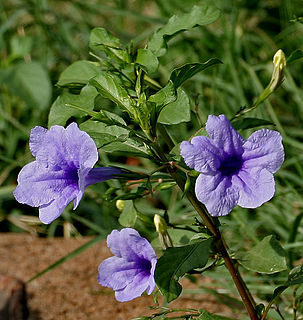
The genus Pritchardia consists of between 24-40 species of fan palms found on tropical Pacific Ocean islands in Fiji, Samoa, Tonga, Tuamotus, and most diversely in Hawaii. The generic name honors William Thomas Pritchard (1829-1907), a British consul at Fiji.

Cotoneaster is a genus of flowering plants in the rose family, Rosaceae, native to the Palaearctic region, with a strong concentration of diversity in the genus in the mountains of southwestern China and the Himalayas. They are related to hawthorns (Crataegus), firethorns (Pyracantha), photinias (Photinia) and rowans (Sorbus).

Brachychiton acerifolius, commonly known as the Illawarra flame tree, is a large tree of the family Malvaceae native to subtropical regions on the east coast of Australia. It is famous for the bright red bell-shaped flowers that often cover the whole tree when it is leafless. Along with other members of the genus Brachychiton, it is commonly referred to as a Kurrajong.

Strobilanthes kunthiana, kurinji or neelakurinji, is a shrub that is found in the shola forests of the Western Ghats in South India. Nilgiri Hills, which literally means the blue mountains, got their name from the purplish blue flowers of Neelakurinji that blossoms only once in 12 years. Of all long interval bloomers Strobilanthes kunthiana is the most rigorously demonstrated, with documented bloomings in 1838, 1850, 1862, 1874, 1886, 1898, 1910, 1922, 1934, 1946, 1958, 1970, 1982, 1994, 2006 and 2018.

Ruellia is a genus of flowering plants commonly known as ruellias or wild petunias. They are not closely related to petunias (Petunia) although both genera belong to the same euasterid clade. The genus was named in honor of Jean Ruelle, herbalist and physician to Francis I of France and translator of several works of Dioscorides.
Plietesials are plants that grow for a number of years, flower gregariously (synchronously), set seed and then die. The length of the cycle can vary between 8 and 16 years. For example, the Neelakurinji plant flowers every 12 years and bloomed as expected in 2006 in the Munnar region of Kerala, India.

Isopogon anethifolius, commonly known as narrowleaf- or narrow-leafed drumsticks, is a shrub in the family Proteaceae. The species is found only in coastal areas near Sydney in New South Wales, and to the immediate west. It occurs naturally in woodland, open forest and heathland on sandstone soils. An upright shrub, it can reach to 3 m in height, with terete leaves that are divided and narrow. The yellow flowers appear from September to December and are prominently displayed. They are followed by round grey cones, which give the plant its common name of drumsticks. The small hairy seeds are found in the old flower parts.

Hemigraphis repanda is a species of plant of family Acanthaceae.

Strobilanthes callosa Nees (Synonym: Carvia callosa Bremek) is a shrub found mainly in the low hills of the western ghats all along the west coast of India. Its standardized Hindi language name is maruadona (मरुआदोना) by which it is called in the state of Madhya Pradesh where it is also found. In the state of Maharashtra in the Marathi language and other local dialects and in the neighboring state of Karnataka the shrub is locally known as karvi, sometimes spelled in English as karvy.

Persoonia lanceolata, commonly known as lance-leaf geebung, is a shrub native to New South Wales in eastern Australia. It reaches 3 m (9.8 ft) in height and has smooth grey bark and bright green foliage. Its small yellow flowers grow on racemes and appear in the austral summer and autumn, followed by green fleshy fruits which ripen the following spring. Within the genus Persoonia, P. lanceolata belongs to the lanceolata group of 58 closely related species. It interbreeds with several other species found in its range.
Dyschoriste is a genus of flowering plants in the family Acanthaceae. Members of the genus are commonly known as snakeherb.

Isopogon latifolius is a shrub of the family Proteaceae that is endemic to the southwest botanical province of Western Australia.

Persoonia elliptica, commonly known as snottygobble or spreading snottygobble, is a plant in the family Proteaceae and is endemic to the south-west of Western Australia. It is an erect shrub or small tree with egg-shaped or lance-shaped leaves and groups of cylindrical yellow flowers. It usually grows in woodland or forest dominated by jarrah or marri within 50 km (30 mi) of the coast.

Persoonia chamaepeuce, commonly known as the dwarf geebung or heathy geebung, is a plant in the family Proteaceae and is endemic to south-eastern Australia. It is a prostrate shrub with crowded, linear leaves and yellow flowers in the leaf axils.
Strobilanthes japonica is a flowering herbaceous perennial plant from Asia, one of around 350 plants of the genus Strobilanthes. The 20–50 cm ornamental plant is cultivated in Japan and China, and blooms in autumn with 1.5 cm purple to white funnel-shaped flowers.

Helinus is a genus of flowering plants in the buckthorn family, Rhamnaceae. They are native to tropical and subtropical regions of Africa and Asia, and may be trees, climbing shrubs or lianas. They are unarmed and the branches have coiled tendrils. The alternate leaves have entire margins, and pinnately arranged venation.

Persoonia saccata, commonly known as snottygobble, and cadgeegurrup in indigenous language, is a plant in the family Proteaceae and is endemic to the south-west of Western Australia. It is usually an erect shrub and has linear leaves and groups of up to fifty or more irregularly shaped, yellow flowers which are hairy on the outside. It usually grows in woodland dominated by jarrah, marri or large Banksia species.

Allenrolfea is a genus of shrubs in the family Amaranthaceae. The genus was named for the English botanist Robert Allen Rolfe. There are three species, ranging from North America to South America.
Strobilanthes wightiana is a species of plant in the genus Strobilanthes of the family Acanthaceae, commonly called the "Wight's kurinji". It is endemic to Southern Western Ghats. It prefers evergreen and semi-evergreen forests.



















